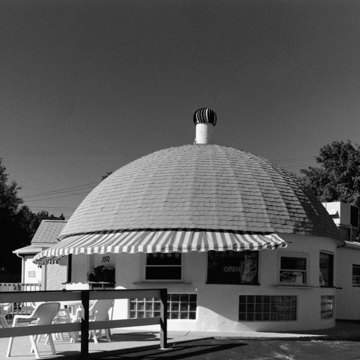Once Americans took to the automobile, the drive-in restaurant became almost inevitable. In 1921, male servers at the Pig Stands, a chain of barbecue restaurants in Dallas, Texas, began claiming drive-up customers by jumping onto the running boards of their cars. By the 1950s, roller-skating female “carhops” took orders and hung meal trays on open car windows. Drive-ins also became gathering places for teenagers to show off their cars and flirt. Many family-friendly drive-ins frowned on the mobs of teenagers, who tended to place small orders and loiter for hours. But the Arctic Circle Diner (the name spoofed Wisconsin’s frigid winter weather) thrived for over a decade on a predominantly teenage clientele. Harold Stein built the diner around 1951 but soon sold it to Albert and Ethyl Weith, who encouraged the high school set to hang out, eat steak sandwiches and frozen custard, listen to the latest hits on the jukebox, and dance on the blacktop.
Drive-ins often assumed whimsical shapes to capture passing motorists’ attention. Fittingly, the Arctic Circle looks like an igloo. Panels of ice (glass block) pierce curving snow-white (stucco) walls, which rise to a dome of stainless steel. An artificial penguin once stood at the corner, balancing a spinning ice cream cone on its bill. Today the Arctic Circle is a dine-in restaurant, but the windows where carhops placed orders and picked up trays survive.







